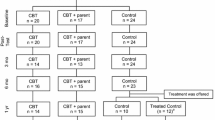Abstract
This study reports the 1-year follow-up of a cognitive-behavioral treatment for anxiety disorders in children and adolescents. Thirty-seven anxiety-disordered youth (aged 8–14 years at the time of treatment) were randomly assigned to individual cognitive-behavioral treatment (ICBT), group cognitive-behavioral treatment (GCBT), or a waitlist control (WLC) condition. Previously reported posttreatment results demonstrated significant reductions in anxiety whereas children in the WLC failed to demonstrate changes in report of anxiety or in diagnostic status. At the present 1-year follow-up, 81% of ICBT and 77% of GCBT children no longer met criteria for their primary anxiety disorder. Multivariate analyses of variance demonstrated maintenance of treatment gains for both ICBT and CGBT but failed to reveal differences between the conditions. Results not only suggest the nondifferential efficacy of individual and group cognitive-behavioral treatments for anxiety-disordered children but also add to the evidence suggesting GCBT as a “probably efficacious treatment.”
Similar content being viewed by others
References
Barrett, P. M. (1998). Evaluation of cognitive-behavioral group treatments for childhood anxiety disorders. Journal of Clinical Child Psychology, 27, 459–468.
Barrett, P. M., Dadds, M. R., & Rapee, R. M. (1996). Family treatment of childhood anxiety: A controlled trial. Journal of Consulting and Clinical Psychology, 64, 333–342.
Barrett, P. M., Duffy, A. L., Dadds, M. R., & Rapee, R. M. (2001). Cognitive-behavioral treatment of anxiety disorders in children: Long-term (6-year) follow-up. Journal of Consulting and Clinical Psychology, 69, 135–141.
Costello, E. J., & Angold, A. (1995). Epidemiology. In J. S. March (Ed.), Anxiety disorders in children and adolescents (pp. 109–124). New York: Guilford.
Flannery-Schroeder, E., & Kendall, P. C. (1996). Cognitive-behavioral therapy for anxious children: Therapist manual for group treatment. Ardmore, PA: Workbook.
Flannery-Schroeder, E., & Kendall, P. C. (2000). Group and individual cognitive-behavioral treatments for youth with anxiety disorders: A randomized clinical trial. Cognitive Therapy and Research, 24, 251–278.
Kendall, P. C. (2000). Cognitive-behavioral therapy for anxious children: Therapist manual (2nd ed.). Ardmore, PA: Workbook.
Kendall, P., Flannery-Schroeder, E., Panicelli-Mindel, S., Southam-Gerow, M., Henin, A., & Warman, M. (1997). Therapy for youths with anxiety disorders: A second randomized clinical trial. Journal of Consulting and Clinical Psychology, 65, 366–380.
Kendall, P. C., Safford, S., Flannery-Schroeder, E., & Webb, A. (in press). Child anxiety treatment: Maintenance of outcomes in adolescence and impact on substance use and depression at 7.4 year follow-up. Journal of Consulting and Clinical Psychology.
Manassis, K., Mendlowitz, S. L., Scapillato, D., Avery, D., Fiksenbaum, L., Freire, M., et al. (2002). Group and individual cognitive-behavioral therapy for childhood anxiety disorders. A randomized trial. Journal of the American Academy of Child and Adolescent Psychiatry, 41(12),1423–1430.
Mendlowitz, S. L., Manassis, K., Bradley, S., Scapillato, D., Miezitis, S., & Shaw, B. F. (1999). Cognitive-behavioral group treatments in childhood anxiety disorders: The role of parental involvement. Journal of the American Academy of Child and Adolescent Psychiatry, 38, 1223–1229.
Muris, P., Meesters, C., & van Melick, M. (2002). Treatment of childhood anxiety disorders: A preliminary comparison between cognitive-behavioral group therapy and a psychological placebo intervention. Journal of Behavior Therapy and Experimental Psychiatry, 33, 143–158.
Pine, D. S., Cohen, P., Gurley, D., Brook, J., & Ma, Y. (1998). The risk for early-adulthood anxiety and depressive disorders in adolescents with anxiety and depressive disorders. Archives of General Psychiatry, 55, 56–64.
Silverman, W. K., Kurtines, W. M., Ginsburg, G. S., Weems, C. F., Lumpkin, P., White, C., et al. (1999). Treating anxiety disorders in children with group cognitive-behavioral therapy: A randomized clinical trial. Journal of Consulting and Clinical Psychology, 67, 995–1003.
Task Force on Promotion and Dissemination of Psychological Procedures. (1995). Training in and dissemination of empirically validated psychological treatments: Report and recommendations. The Clinical Psychologist, 48, 3–23.
Author information
Authors and Affiliations
Corresponding author
Rights and permissions
About this article
Cite this article
Flannery-Schroeder, E., Choudhury, M.S. & Kendall, P.C. Group and Individual Cognitive-Behavioral Treatments for Youth With Anxiety Disorders: 1-Year Follow-Up. Cogn Ther Res 29, 253–259 (2005). https://doi.org/10.1007/s10608-005-3168-z
Issue Date:
DOI: https://doi.org/10.1007/s10608-005-3168-z



